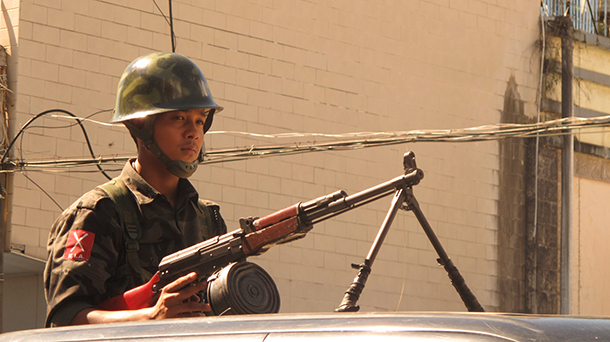A renewed offensive against ethnic Kachin rebels in north Burma this week could prolong ceasefire negotiations, Kachin activists and rebel leaders say.
Sources in Kachin State say government troops attacked the Kachin Independence Army (KIA) with heavy weapons and artillery shelling over the weekend at a frontline outpost near Nam Lim Pa village in Mansi Township, in southern Kachin State. Clashes also continued on Tuesday, as the Kachin people, who are mostly Christian, prepared to celebrate Christmas Eve.
“It is not accidental fighting,” Seng Aung, a Kachin activist who works with the Kachin Peace Creation Group, told The Irrawaddy on Thursday. “We know they came deliberately and attacked the KIA troops using heavy weapons. Because it is a serious offensive, it could slow the pace of trust-building and the peace process.”
In previous fighting in mid-November, also near Nam Lim Pa, thousands of civilians were displaced. Government troops reportedly launched attacks on Nov. 16, with about 2,000 Kachin civilians fleeing from their homes and hiding in the surrounding jungle.
“We used to ask them not to attack our troops, but they have not listened to us,” James Lum Dau, the KIO deputy chief of foreign affairs, told The Irrawaddy. He said the KIA’s Brigade 3 and Brigade 4 had been attacked over the past week.
“This offensive has a major impact on the peace talks,” he added, saying his organization did not yet know whether it would sign a nationwide ceasefire deal that the government hopes to secure soon with ethnic armed groups around the country.
An estimated 100,000 people have been displaced by fighting since clashes first broke out in 2011, when a 17-year ceasefire fell apart. Since then, the KIA and the government army have both launched offensive against each other. Over Christmas last year violence also escalated, with the government army conducting air raids against Lajayang, a strategically coveted outpost.
Starting in February, the government and the KIA’s political wing, the Kachin Independence Organization (KIO), have met for peace talks and have signed an agreement to de-escalate hostilities, but a ceasefire remains elusive.
Khon Ja of the Kachin Peace Network, a Rangoon-based relief organization that provides aid to displaced Kachin people, said Nam Lim Pa has been deserted amid fighting over the past week.
“No villagers have stayed in Nam Lim Pa village,” she told The Irrawaddy. “All of them fled their homes, and the village is now occupied by the government army.”
She agreed that on-and-off fighting launched by government troops could delay the peace process, not only with the KIO but perhaps also with other ethnic rebel groups.
“It does not only affect the peace deal between the government and the KIO,” she said. “It also affects peace deals with other ethnic armed groups, because the fighting has broken out not only in Kachin State, but also in Shan State and ethnic Ta’aung rebel areas.”
She added, “They may not sign the national ceasefire agreement if they cannot build trust.”
Burma’s government has signed ceasefire agreements with all major ethnic armed groups other than the KIA and the Ta’aung army, and the government says it hopes to consolidate these agreements into a nationwide ceasefire deal soon, potentially during meetings early next year in the Karen State capital of Pa-an.
The ethnic groups’ working committee, known as the Nationwide Ceasefire Coordination Team (NCCT), also plans to meet in the next week with the Myanmar Peace Center (MPC), a government-affiliated organization that has facilitated peace talks between the government peace negotiation team and rebel leaders. It is expected that they will discuss the nationwide ceasefire agreement during this meeting in the northern Thai city of Chiang Mai.

















